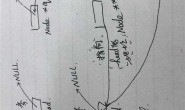|
Again, it is a simple matter to modify this program to use standard I/O techniques instead of command-line arguments to provide filenames. C primer plus 只提了一下,说很简单,→_→ 怎么弄额? 用 scanf ?用什么标识符? 还是用函数? |
|
#3 |
回复2楼: 就一个简单的小程序 把一个文件中的内容复制到另一个文件中 |
#410分 |
//赋值文本文件
#include <stdio.h>
int main(void)
{
FILE *fi, *fo;
fi = fopen("1.txt", "rb");
fo = fopen("2.txt", "wb");
char buf[128];
while (1)
{
if (NULL == fgets(buf, sizeof(buf), fi)) break;
fprintf(fo, "%s", buf);
}
fclose(fi);
fclose(fo);
return 0;
}
|
#510分 |
Again, it is a simple matter to modify this program to use standard I/O techniques instead of command-line arguments to provide filenames.
粗略地翻译一下,就是让你修改程序,使用标准I/O(技术)来提供文件名,而不是用命令行参数来提供文件名。 所谓的标准I/O,就是scanf这些东西了。 使用命令行提供文件名运行起来是这样的: process.exe foo.txt 对于int main(int argc, char * argv[])来说,argv[1]即为”foo.txt” 使用I/O,运行起来就是这样: cmd> process.exe please input the file you want to process: foo.txt … 所以代码中大概会有这样的语句: char filename[80]; printf(“please input the file you want to process: “); scanf(“%s”, filename); process(filename): … 所以说,英语也是一种语言。 |
#610分 |
#include <stdio.h>
#include <string.h>
#ifndef PATH_MAX
#define PATH_MAX 255
#endif
char *
strchop(char *s)
{
size_t len;
if (s) {
len = strlen(s);
if (len > 0 && (""\n"" == s[len - 1] || ""\r"" == s[len - 1]))
s[len - 1] = ""\0"";
len--;
if (len > 0 && (""\n"" == s[len - 1] || ""\r"" == s[len - 1]))
s[len - 1] = ""\0"";
}
return s;
}
int
main(int argc, char *argv[])
{
char source[PATH_MAX] = {0};
char target[PATH_MAX] = {0};
if (1 == argc) {
/* 通过标准 I/O 获取文件名 */
printf("source: ");
strchop(fgets(source, sizeof(source), stdin));
printf("target: ");
strchop(fgets(target, sizeof(target), stdin));
} else {
/* 通过命令行参数获取文件名 */
strcpy(source, argv[1]);
strcpy(target, argv[2]);
}
printf("source=[%s]\n", source);
printf("target=[%s]\n", target);
return 0;
}
|




